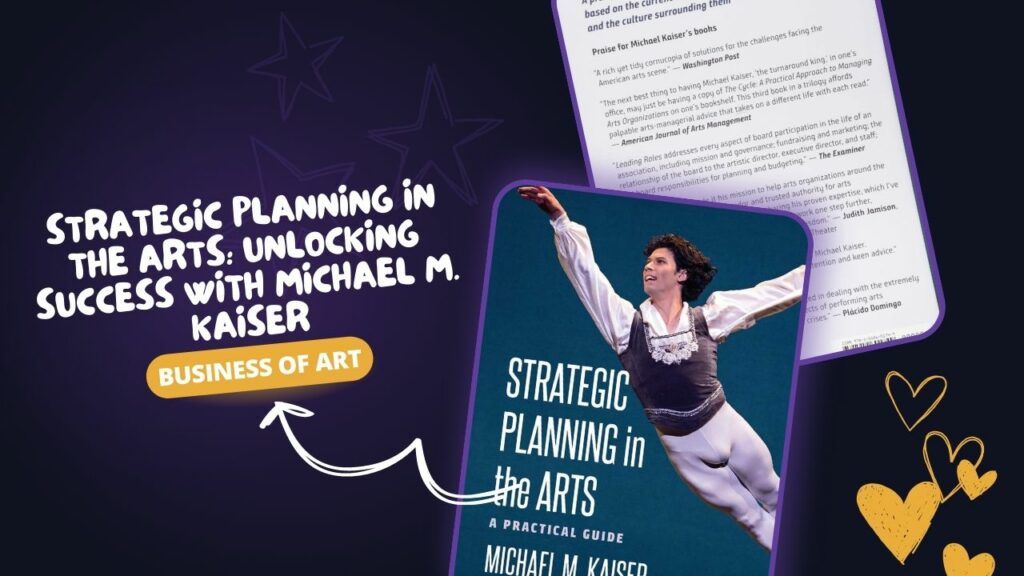eBook This – Are you struggling to get your arts organization to thrive? Discover the invaluable insights of Michael M. Kaiser’s strategic planning in the arts and unlock your organization’s true potential.
Introduction
In the world of arts and culture, a solid strategic plan can be the key to long-lasting success.
One of the most respected voices in the field, Michael M. Kaiser, has dedicated his career to teaching arts leaders how to thrive, even in challenging times.
In this article, we’ll explore Kaiser’s approach to strategic planning in the arts, which has helped countless organizations realize their goals and achieve greater impact.
From fostering a strong institutional identity to building a robust marketing strategy, we’ll delve into the essential components of Kaiser’s framework.
Michael M. Kaiser: A Visionary in the Arts World
Michael M. Kaiser has built an impressive career in arts management, serving as the executive director for several major institutions, including the Royal Opera House, the Alvin Ailey American Dance Theater, and the John F. Kennedy Center for the Performing Arts.
His expertise and vision have earned him a reputation as a turnaround specialist, revitalizing struggling organizations and setting them on a path to success.
As a result, his approach to strategic planning in the arts has become highly sought after by leaders worldwide.
The Importance of a Strong Institutional Identity
At the core of Kaiser’s strategic planning philosophy is the concept of a strong institutional identity.
He believes that arts organizations must have a clear, well-defined mission that sets them apart from their competitors.
This identity should be reflected in every aspect of the organization, from programming and artistic choices to marketing and fundraising efforts.
By creating a unique institutional identity, arts organizations can generate excitement and loyalty among their audiences, leading to increased attendance and financial stability.
Programming as the Cornerstone of Success
Kaiser emphasizes the importance of programming in an arts organization’s strategic plan. He argues that programming should be bold, innovative, and reflective of the organization’s identity.
This approach not only attracts new audiences but also inspires existing patrons to return for more.
Kaiser suggests that organizations should focus on developing a multi-year programming plan that includes a mix of high-profile, attention-grabbing projects and smaller, more experimental works.
This balance ensures that the organization remains relevant and artistically vibrant, while also providing opportunities for emerging artists and new ideas to flourish.
Marketing and Audience Development
Marketing is another critical component of Kaiser’s strategic planning framework. He asserts that marketing should be an ongoing, consistent effort, rather than a series of isolated campaigns.
By focusing on building long-term relationships with audiences, arts organizations can create a loyal following that is more likely to attend events and contribute financially.
To achieve this, Kaiser advises organizations to invest in audience development, which involves identifying target demographics, creating tailored marketing messages, and using data-driven strategies to reach new and existing patrons.
Additionally, he highlights the importance of leveraging digital marketing channels, such as social media and email, to maintain engagement and drive ticket sales.
Financial Planning and Fundraising
Kaiser also emphasizes the role of sound financial planning in the success of an arts organization.
He advocates for a proactive approach to fundraising, which involves identifying potential donors, building relationships, and creating compelling cases for support.
One of Kaiser’s key fundraising principles is the concept of “family participation.” He encourages organizations to involve board members, staff, and volunteers in the fundraising process, creating a culture of shared responsibility and commitment to the organization’s financial well-being.
Building a Culture of Collaboration
Lastly, Kaiser highlights the importance of fostering a collaborative culture within an arts organization.
By encouraging open communication, cooperation, and a shared sense of purpose among staff, board members, and artists, organizations can create an environment that is conducive to creative problem-solving and long-term growth.
Kaiser believes that a healthy organizational culture is crucial for implementing and sustaining the strategic plan, as it helps align everyone’s efforts towards the same goals.
Key Takeaways from Michael M. Kaiser’s Strategic Planning Approach
To summarize, Michael M. Kaiser’s approach to strategic planning in the arts emphasizes the following key elements:
- A strong institutional identity that sets the organization apart and guides all aspects of its operations.
- Bold and innovative programming that reflects the organization’s identity and attracts diverse audiences.
- Consistent and targeted marketing efforts aimed at building long-term relationships with patrons.
- Proactive financial planning and fundraising that involves the entire organization in the pursuit of financial stability.
- A collaborative organizational culture that fosters communication, cooperation, and a shared sense of purpose.
Conclusion
Strategic planning in the arts, as championed by Michael M. Kaiser, is essential for organizations that wish to thrive in an increasingly competitive landscape.
By focusing on a strong institutional identity, innovative programming, effective marketing, robust financial planning, and a culture of collaboration, arts organizations can set themselves on a path to lasting success.
As the world of arts and culture continues to evolve, the insights and expertise of leaders like Kaiser will remain invaluable for those seeking to navigate the challenges and opportunities that lie ahead.
Popular FAQs About Michael M. Kaiser’s Books on Strategic Planning in the Arts
What are some popular books by Michael M. Kaiser on strategic planning in the arts?
Michael M. Kaiser has written several influential books on strategic planning and arts management, including:
- The Art of the Turnaround: Creating and Maintaining Healthy Arts Organizations
- Leading Roles: 50 Questions Every Arts Board Should Ask
- The Cycle: A Practical Approach to Managing Arts Organizations
- Curtains?: The Future of the Arts in America
Who can benefit from reading Michael M. Kaiser’s books on strategic planning in the arts?
Kaiser’s books are beneficial for a wide range of readers, including arts administrators, board members, artists, fundraisers, and anyone interested in learning more about the management and sustainability of arts organizations. His insights are valuable for both established organizations and emerging groups looking to create a strong foundation for success.
What is the main focus of “The Art of the Turnaround”?
“The Art of the Turnaround” is a comprehensive guide to revitalizing struggling arts organizations. In the book, Kaiser shares his experiences and insights from leading numerous organizations through successful turnarounds.
He outlines ten essential rules for financial and artistic success, offering practical advice and real-world examples for implementing effective strategies.
How does “The Cycle” differ from Kaiser’s other books?
“The Cycle” delves into a specific model for managing arts organizations, which Kaiser developed based on his extensive experience in the field.
The book presents a practical approach that focuses on the interdependent relationships among programming, marketing, fundraising, and board development.
By understanding and managing these relationships, arts leaders can create a self-sustaining cycle of success for their organizations.
Are Michael M. Kaiser’s books suitable for arts organizations outside the United States?
While Kaiser’s experiences are primarily based on his work with American arts organizations, the principles and strategies he outlines in his books can be applied to arts organizations worldwide.
The challenges faced by arts organizations are often universal, and Kaiser’s insights into strategic planning, fundraising, marketing, and leadership can be valuable for arts leaders across the globe.







